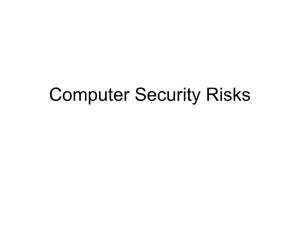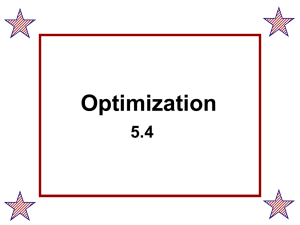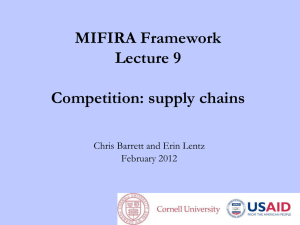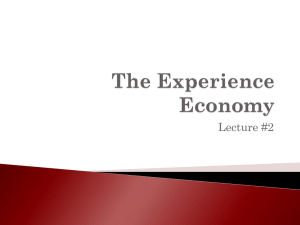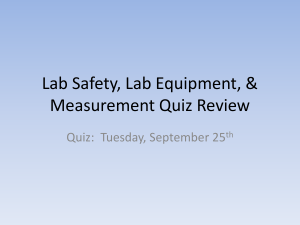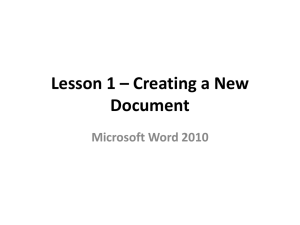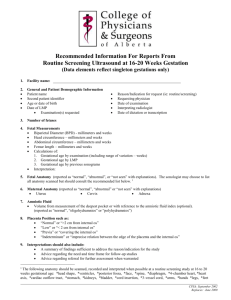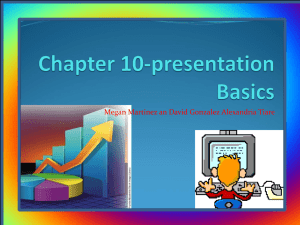Your paper`s title starts here: Please center use (Times New Roman
advertisement
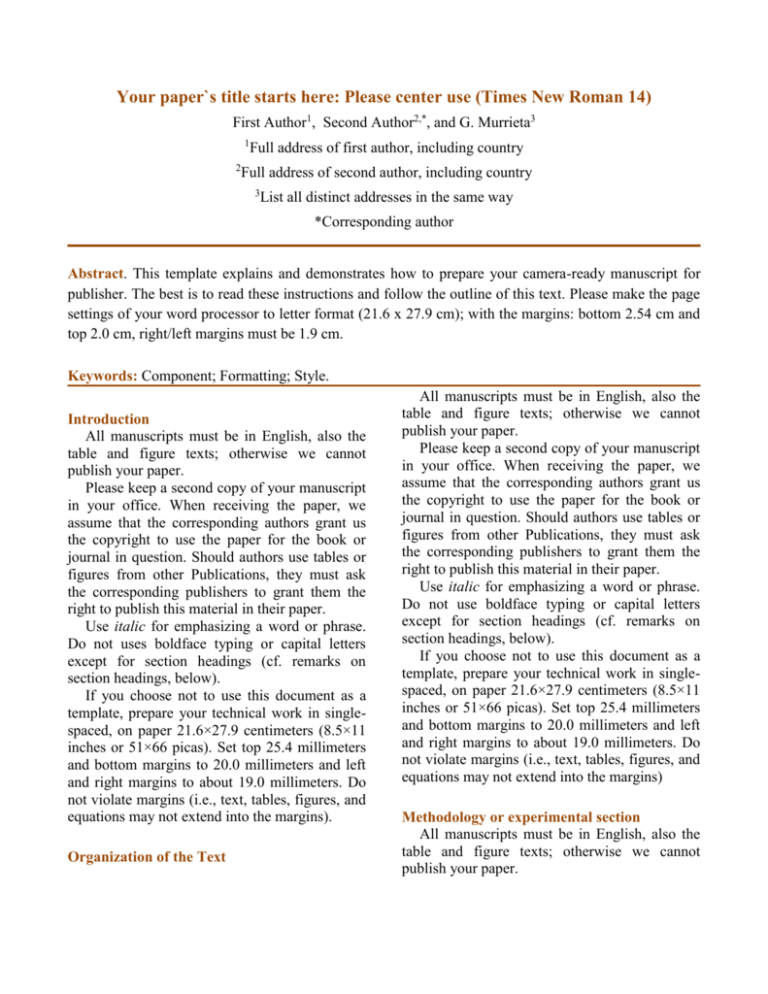
Your paper`s title starts here: Please center use (Times New Roman 14)
First Author1, Second Author2,*, and G. Murrieta3
1
2
Full address of first author, including country
Full address of second author, including country
3
List all distinct addresses in the same way
*Corresponding author
Abstract. This template explains and demonstrates how to prepare your camera-ready manuscript for
publisher. The best is to read these instructions and follow the outline of this text. Please make the page
settings of your word processor to letter format (21.6 x 27.9 cm); with the margins: bottom 2.54 cm and
top 2.0 cm, right/left margins must be 1.9 cm.
Keywords: Component; Formatting; Style.
Introduction
All manuscripts must be in English, also the
table and figure texts; otherwise we cannot
publish your paper.
Please keep a second copy of your manuscript
in your office. When receiving the paper, we
assume that the corresponding authors grant us
the copyright to use the paper for the book or
journal in question. Should authors use tables or
figures from other Publications, they must ask
the corresponding publishers to grant them the
right to publish this material in their paper.
Use italic for emphasizing a word or phrase.
Do not uses boldface typing or capital letters
except for section headings (cf. remarks on
section headings, below).
If you choose not to use this document as a
template, prepare your technical work in singlespaced, on paper 21.6×27.9 centimeters (8.5×11
inches or 51×66 picas). Set top 25.4 millimeters
and bottom margins to 20.0 millimeters and left
and right margins to about 19.0 millimeters. Do
not violate margins (i.e., text, tables, figures, and
equations may not extend into the margins).
Organization of the Text
All manuscripts must be in English, also the
table and figure texts; otherwise we cannot
publish your paper.
Please keep a second copy of your manuscript
in your office. When receiving the paper, we
assume that the corresponding authors grant us
the copyright to use the paper for the book or
journal in question. Should authors use tables or
figures from other Publications, they must ask
the corresponding publishers to grant them the
right to publish this material in their paper.
Use italic for emphasizing a word or phrase.
Do not use boldface typing or capital letters
except for section headings (cf. remarks on
section headings, below).
If you choose not to use this document as a
template, prepare your technical work in singlespaced, on paper 21.6×27.9 centimeters (8.5×11
inches or 51×66 picas). Set top 25.4 millimeters
and bottom margins to 20.0 millimeters and left
and right margins to about 19.0 millimeters. Do
not violate margins (i.e., text, tables, figures, and
equations may not extend into the margins)
Methodology or experimental section
All manuscripts must be in English, also the
table and figure texts; otherwise we cannot
publish your paper.
Please keep a second copy of your manuscript
in your office. When receiving the paper, we
assume that the corresponding authors grant us
the copyright to use the paper for the book or
journal in question. Should authors use tables or
figures from other Publications, they must ask
the corresponding publishers to grant them the
right to publish this material in their paper.
Use italic for emphasizing a word or phrase.
Do not use boldface typing or capital letters
except for section headings (cf. remarks on
section headings, below).
If you choose not to use this document as a
template, prepare your technical work in singlespaced, on paper 21.6×27.9 centimeters (8.5×11
inches or 51×66 picas). Set top 25.4 millimeters
and bottom margins to 20.0 millimeters and left
and right margins to about 19.0 millimeters. Do
not violate margins (i.e., text, tables, figures, and
equations may not extend into the margins).
Results and discussion
All manuscripts must be in English, also the
table and figure texts, otherwise we cannot
publish your paper.
Please keep a second copy of your manuscript
in your office. When receiving the paper, we
assume that the corresponding authors grant us
the copyright to use the paper for the book or
journal in question. Should authors use tables or
figures from other Publications, they must ask
the corresponding publishers to grant them the
right to publish this material in their paper.
Page Numbers. Do not number your paper:
(Subsection sample).
Tables. (refer with: Table 1, Table 2, ...)
should be presented as part of the text, but in
such a way as to avoid confusion with the text. A
descriptive title should be placed above each
table. Units in tables should be given in square
brackets (meV).
Special Signs. for example , α γ μ Ω () ≥ ± ●
Γ {11 2 0} should always be written in with the
fonts Times New Roman or Arial, especially also
in the figures and tables.
Macros. Do not use any macros for the
figures and tables. (We will not be able to
convert such papers into our system)
Language. All text, figures and tables must
be in English.
Figures. Figures (refer with: Fig. 1, Fig. 2, ...)
also should be presented as part of the text,
leaving enough space so that the caption will not
be confused with the text. The caption should be
self-contained and placed below or beside the
figure. Generally, only original drawings or
photographic reproductions are acceptable.
Utmost care must be taken to insert the figures in
correct alignment with the text. For best quality
the pictures should have a resolution of 300
dpi(dots per inch).
Color figures are welcome for the online
version of the journal. Generally, these figures
will be reduced to black and white for the print
version.
Equations. Equations (refer with: Eq. 1,
Eq. 2, ...). There should be one line of space
above the equation and one line of space below it
before the text continues. The equations have to
be numbered sequentially, and the number put in
parentheses at the right-hand edge of the text.
Equations should be punctuated as if they were
an ordinary part of the text. Punctuation appears
after the equation but before the equation
number, e.g.
a+b=c1
(1)
Equations (refer with: Eq. 1, Eq. 2, ...) should
be indented 5 mm (0.2"). There should be one
line of space above the equation and one line of
space below it before the text continues. The
equations have to be numbered sequentially, and
the number put in parentheses at the right-hand
edge of the text. Equations should be punctuated
as if they were an ordinary part of the text.
Table 1. Table headings.
Table
Head
copy
Table Column Head
Table column subhead
Subhead
a
More table copy
Subhead
Color figures are welcome for the online
version of the journal. Generally, these figures
will be reduced to black and white for the print
version.
Color figures are welcome for the online
version of the journal. Generally, these figures
will be reduced to black and white for the print
version.
Color figures are welcome for the online
version of the journal. Generally, these figures
will be reduced to black and white for the print
version.
información de origen proporcionada para el
documento.
Cada vez que cree una nueva fuente de
información, ésta se guarda en el equipo para que
pueda buscar y utilizar cualquier fuente de
información que haya creado.
Puede elegir el estilo bibliográfico que desee
y puede agregar nuevos estilos de bibliografía.
Agregar una nueva cita y una fuente de
información a un documento
1. En la ficha Referencias, en el grupo Citas y
bibliografía, haga clic en la flecha situada
junto
a
la
lista
Estilo.
2. Haga clic en el estilo que desea usar
para la cita y la fuente de información.
Figure 1. Figure footing.
Color figures are welcome for the online
version of the journal. Generally, these figures
will be reduced to black and white for the print
version.
Literature References
References are cited in the text just by square
brackets [1] (Example: Reference to a book).
Two or more references at a time may be put in
one set of brackets [2,3] (Examples: Reference to
article). The references are to be numbered in the
order in which they are cited in the text and are
to be listed at the end of the contribution under a
heading References, see our example below.
Crear una bibliografía
Una bibliografía es una lista de fuentes de
información consultadas o citadas durante la
creación de los documentos y que normalmente
se incluye al final de éstos. En Microsoft Word
2010, se pueden generar bibliografías
automáticamente tomando como base la
3. Selecciones IEEE- Reference order
(Ver instrucciones de instalación).
4. En el grupo Citas y bibliografía de la
ficha Referencias, haga clic en
Insertar
cita.
5. Siga uno de estos procedimientos:
Para agregar la información de origen,
haga clic en Agregar nueva fuente.
Para agregar un marcador de posición,
de manera que pueda crear una cita y
rellenar más adelante la información
de origen, haga clic en Agregar nuevo
marcador de posición. Aparece un
signo de interrogación junto a fuentes
de marcador de posición en el
Administrador de fuentes.
6. Comience por rellenar la información
de origen haciendo clic en la flecha
que aparece junto a Tipo de fuente
bibliográfica.
Por ejemplo, la fuente de información
podría ser un libro, un informe o un sitio
Web.
7. Rellene la información bibliográfica
referente a la fuente de información.
Para agregar más información acerca
de una fuente de información, active la
casilla de verificación Mostrar todos
los campos bibliográficos.
Summary
If you follow the “checklist” your paper will
conform to the requirements of the publisher and
facilitate a problem-free publication process.
Acknowledgement
This research was financially supported by the
National Science Foundation.
References
[1] W. Strunk Jr. and E.B. White, The Elements of
Style, 3rd ed. New York: Macmillan, 1979.
[2] A. Aguayo, G. Murrieta, and R. De Coss, Physical
Review B, vol. 65, no. 9, p. 092106, 2002.
[3] F. L. Pérez Sánchez, J. R. Santos Castillo, and E.
Chigo Anota, Mexican Journal of Materials
Science and Engineering, vol. 1, no. 3, pp. 52-58,
2014.
